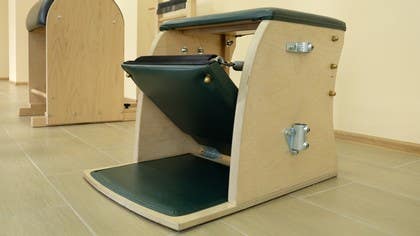
The Wunda Chair: Small but Mighty
The Wunda Chair is an amazing piece of traditional Pilates apparatus. Used in conjunction with the Reformer, Cadillac, Mat, Barrels, and all the smaller apparatus, the Wunda chair gives you myriad options to improve your Pilates prowess.
How does the Wunda Chair fit into the greater Pilates System? What makes Chair workouts so challenging? Can anyone benefit from Wunda Chair exercises? And why is it so tiny?
Here are a few things your Pilates instructor may not mention as you sweat it out on the Wunda Chair.
Joe Pilates designed the Wunda Chair as the first in-home exercise equipment.
The Wunda Chair comes with an interesting history and a vast repertoire of exercises. In the month of August, New York City is sweltering. Pilates “Elder” Jay Grimes of Vintage Pilates in Los Angeles, California, was a student at the original Pilates studio there. Grimes recounts that each year Joe Pilates would close his studio in August and make his clients purchase a Wunda Chair to use at home until the studio reopened in September. Joe would give each client a list of exercises as homework. I'm sure when they returned, he could tell if they'd followed his instructions.
Video of Joe's original footage from the 1930s (perhaps an early example of the infomercial?) shows Joe and Clara seated in a domestic tableaux in their living room. Suddenly, Joe leaps up and turns what just a moment ago appeared to be an ordinary household chair into a remarkably familiar looking Wunda Chair. Joe then proceeds to launch into a series of his exercises as Clara looks on. In less than a minute, Joe shows off his invention, his fitness, and the vitality associated with the faithful practice of his method.
The classical Wunda Chair can also be turned upside down and used as a proper chair, complete with a posture-enhancing solid wood back. Bonus: it looks great with other mind-Century pieces.
The Wunda Chair plays a specific role in the greater Pilates System.
In the Pilates studio, Jay Grimes encourages us to be “like an expert chef in a well stocked kitchen.” All the various apparatuses contribute their special ingredients to create strong and supple bodies. Briefly, the Reformer is the real workhorse apparatus, offering a high level of support as we build skill and strengthen our bodies. The Mat is the ultimate test of whether all of our work with the springed apparatus is working (or not). The Cadillac offers us a supportive place to refine our skills away from the moving platform of the Reformer. With our bodies directly attached to the springs, the Cadillac can be a challenging place to work as well.
The three Pilates Chairs (High Chair, Wunda Chair, and Arm Chair) and all the other small apparatus (Foot Corrector, Ped-o-Pull, Barrels, etc.) serve to refine specific skills. The Chairs are a great place to perfect skills you're working on the Reformer or Mat.
The Wunda Chair can help to enhance your workout, and it also features the ultimate challenge of the Pilates Method: defying gravity. Which brings me to my third point:
Even the fundamental Wunda Chair exercises are not easy to do.
I hesitate to call any of the Wunda Chair repertoire “easy.” Looking at the difference between a Reformer and a Wunda Chair reveals just how small, and therefore less supportive, the Chair is. On the Reformer your whole body is able to lie down. Lying down on the Wunda Chair rarely happens and when it does, there's only enough real estate for about half of the torso.
A full Wunda Chair workout demands stamina, heightened control, and precision. Students often learn a handful of Wunda Chair exercises at first, working some exercises on the more supportive High Chair before bringing them to the Wunda. Over time, the student may be able to do an entire workout on the Wunda Chair.
This versatile apparatus can challenge the beginner student as well as the elite athlete. One of my first memories of the Wunda Chair involves the Pull Up. Maybe you also remember the first day you were able to lift up the pedal?
The Wunda Chair takes all your Reformer skills vertical.
Every exercise in the Pilates System demands us to defy gravity. On the Wunda Chair we'll control the closing of the springs just like everywhere else in the Pilates studio. However, we are no longer in a horizontal plane or lying down.
If you have learned to close the carriage in the Elephant on the Reformer, welcome to the Pull-Up on the Wunda Chair, where we'll do the very same action now in a vertical plane.
Consistent workouts all around the Pilates studio will only serve to enhance all of your exercises on the Reformer and take them to the next level. Navigating around the Wunda Chair as you step on and off for your exercises leads to greater control as you negotiate your environment.
Joe Pilates' original name for his method is Contrology, or the study of control. Who's in charge here? You or the apparatus? The Wunda Chair provides perhaps the best place in the Pilates studio to cultivate control.
Are you a Wunda Chair aficionado? Let us know in the comments section.
Comments
You need to be a subscriber to post a comment.
Please Log In or Create an Account to start your free trial.




















